Flock Safety System
Automatic License Plate Readers (ALPR) have long helped law enforcement in solving crimes. ALPRs capture computer-readable images of license plates, allowing law enforcement agencies to compare plate numbers against those of stolen cars or cars driven by people suspected of being involved in criminal activities.
The information by ALPR cameras can help determine whether a vehicle was at the scene of a crime and to discover vehicles that may be associated with each other. Law enforcement agencies can choose to share their information with other agencies. The cameras can also integrate information from national or state crime databases to provide real-time alerts when a vehicle associated with a known suspect or a stolen vehicle passes the camera.
According to the National Conference of State Legislatures, when employed ethically and objectively, ALPRs are an effective force-multiplying tool for law enforcement. A 2011 study by the Police Executive Research Forum concluded that ALPRs used by Mesa, Ariz., Police resulted in “nearly 3 times as many ‘hits’ for stolen vehicles, and twice as many vehicle recoveries.”
Flock Safety communities have reported overall crime reductions of over 70 percent after a period of time utilizing the ALPR system. In some areas, that included an over 60 percent reduction in non-residential burglaries, 80 percent reduction in residential burglary, and an over 40 percent reduction in robberies.
What is Flock Safety?
Flock Safety is a public safety operating system that helps communities and law enforcement work together to eliminate crime, protect privacy, and mitigate bias. We build devices that capture objective evidence and use machine learning to detect and deliver unbiased investigative leads to law enforcement. Flock Safety communities have reported crime reductions of up to 70 percent.
Today, there are over 1,500 Flock Safety communities; we partner with 1200+ law enforcement agencies. The Buffalo County Sheriff’s Office has partnered with the Kearney Police Department under their MOU with the FLOCK Safety System.
Kearney Police Department Flock Transparency Portal
Buffalo County Sheriff’s Office Automated License Plate Reader (ALPR #1346)
Nebraska Revised Statutes – Automatic License Plate Reader Privacy Act 60-3201 to 60-3209
Flock ALPR Data Year End Report
Vigilant Mobile ALPR Year End Report
Off Duty Management

In order to efficiently respond to
requests and manage the employment of off-duty police officers, The Kearney Police
Department has partnered with Off Duty Management to provide services related
to hiring off-duty officers effective September 27,2021.
You may request to
hire off-duty police officers through the Off Duty Management web-based
service, OfficerTRAK®, or calling the number below.
Off Duty Management provides the following to the vendor:
- Online access to information through the OfficerTRAK® software including:
- Job-status
- Officer attendance
- Field notes and media files
- Post orders and instructions
- Past and future shift information
- Full liability coverage for the vendor, the agency, and the officer
- 24/7 vendor service
- Dedicated point of contact for scheduling and invoicing
- Officer payroll
Prohibited Off-Duty Employment*:
- Private detective agencies
- Licensed liquor establishments
- Sell, manufacture, or transport alcoholic beverages
- Collection agencies
- Advertising agencies (use of uniform or office to endorse products or businesses);
- Process server
- Bail bond agency
- Repossessing property or evicting persons or entities from premises
- Assisting in case preparation or investigation for any criminal defense or civil proceedings
- Employment as an investigator or in any capacity involving the use of police records for other than law enforcement purposes
- Employment that would be likely to bring the Police Department or the officer into disrespect, disfavor or ridicule, or involve the officer in a violation of Department policies, procedures or rules
- Other situations, locations or capacities not approved by the Chief of Police.
- Cannot access, use, or convey any data, files or information that is proprietary, is under the control of, or was collected and stored by this or any other law enforcement agency.
- Cannot perform any task or job that would bring discredit or embarrassment to the Kearney Police Department.
*PLEASE
NOTE: the above
list is not an all-inclusive and questions regarding permitted activity should
be forwarded to Off Duty Management.
RATES:
2 Hours minimum per request.
|
Regular
|
$57.50 |
|
Supervisor*
|
$69.00
|
|
Holiday**
|
$69.00 |
|
Emergency***
|
$63.25 |
| Vehicle |
$28.75/HR. $115 Daily M |
| State Sales
Tax 7% for all Security Posts/ No Tax for Traffic Jobs |
*Supervisor Rates: A supervisor is required when four or more
officers are requested.
**Holiday Rates: Rate will apply to the following days: New
Year’s Day, MLK Day, Presidents’ Day, Memorial Day, Juneteenth, Independence
Day, Labor Day, Thanksgiving Day, Day After Thanksgiving, Christmas Eve,
Christmas Day.
***Emergency
Rates: If request is received less than
72 hours prior to assignment the emergency pay rate goes into effect.
Cancellation policy:
Once an assignment has been approved and scheduled; vendors
canceling or reducing assignments are required to pay the full ODM
administrative fees for the first 24 hours of the original assignment. Vendors
canceling or reducing assignments within 48 hours of the start of the
assignment are required to pay the greater of officer hours worked or the
agency minimum hours plus ODM administrative fees for the first 24 hours of the
original assignment.
YOU CAN REQUEST SERVICE BY VISITING THE OFFICERTRAK® WEBSITE
OR CALL OFF DUTY MANAGEMENT 24/7 (308) 281-1827
Sheriff's Department Forms
Application for Employment
Complaint Form
Download and print the firearm purchase certificate application.
Or call our office at 308-233- 5250 and arrange for an application to be mailed to you.
Application Submission Instructions:
1. Complete the application and have it notarized.
2. Provide a photocopy of your Nebraska Driver’s License/State ID with your current address.
* If applicable a photocopy of your permanent resident card.
3. Mail the completed application, required identification photocopy, and $5.00 fee payable to:
Buffalo County Sheriff's Office
P.O. Box 1270
Kearney, NE 68848
Facilities General Information
The Buffalo County Facilities OMP department strives to provide extraordinary, professional and reliable building management services for all of the county facilities. Our Facilities Staff are trained professionals who are committed to providing a clean, safe, secure and functional building environment for both the county staff and the general public. Buffalo County Facilities OMP includes Operations (Custodial and Maintenance), Management (Facility Rental Use and Administrative Services), and Planning (Short term and long term improvements).
The 14 members of the Facilities OMP staff are responsible for maintaining all County Government buildings, including the Courthouse, Judicial Center, County Jail, Highway Department
buildings, Extension Building, 4 office buildings, and a recreation area with a lake and campground. There are over 30 buildings in total. In addition to these facilities, Facilities OMP maintains 11 parking lots, all walkways, steps and lawns adjacent to these areas, including landscaping, and provides snow and ice removal during the winter. The staff meet regularly to review work practices and safety regulations. They take part in additional training to keep up to date on the latest practices and procedures
relative to the cleaning, maintenance, security, and protection of County facilities, employees, and the general public.
"Facilities Operations" includes:
Custodial Services
Our Custodial Staff are trained cleaning professionals who are committed to providing a safe, clean and presentable building environment. We provide custodial services for 10 of our County buildings, their entrances, surrounding grounds, and parking areas. These buildings include:
--Buffalo County Courthouse
--Buffalo County Judicial Center
--Buffalo County Jail/EOC Center
--DHHS
--Adult Probation
--Juvenile Probation
--Extension Building
--215 Office Building
--Buffalo County Highway Department
--Buffalo County Weed District
Maintenance Services
Our Maintenance Staff are trained maintenance professionals who are committed to providing a safe, secure and functional building environment. Their work includes:
--Planned/Preventative Maintenance - includes inspections, servicing, general upkeep to buildings, equipment and grounds.
--Reactive/Unplanned Maintenance - repairing breakdowns of our facilities and grounds
--Overseeing underground fuel storage tanks/piping/lines and ensuring compliance with government regulations
--Monitoring/Maintaining Building Management Systems including HVAC controls, fire alarm systems, etc.
--Emergency Maintenance - assessing/repairing/coordinating repairs to critical system breakdowns
--Snow and Ice Removal
"Facilities Management" includes:
Facility Rental Use
The Facilities OMP department is responsible for facilitating the rental use of county facilities. At this time the principle location of this usage is the Buffalo County Extension Building. The responsibility includes:
--Schedule the usage of the Extension Building meeting rooms & kitchen, and maintain the master schedule
--Process all requests for usage of the meeting rooms & kitchen, and insure compliance with Board policies and regulations
--Execute rental contracts for outside group usage and collect rental fees associated with each agreement
--Verify appropriate requirements are met by groups using the facility
--Provide Facility Assistant when required, for groups with alcohol
--Provide proper access to scheduled groups
--Prep building for usage and follow up to ensure that it has been returned in proper condition
Administrative Services
Operations
--Ensure compliance with employment rules/regulations, county policies, and all applicable state and federal laws/regulations
--Oversee the daily operations of the Facilities OMP workforce and the work assignments
--Monitor, inspect and review the daily operations of the County facilities and grounds
--Manage installations, repairs, equipment testing and contracted maintenance by outside sources
--Oversee the development and implementation of operational policies and procedures
--Utilize and administer facility/building management software systems to manage the county facilities
--Coordinate professional development of Facilities OMP staff through training and workshops
--Have a representative on the County safety committee and any other committee as requested
Procurement
--Review and manage contracts related to county facilities
--Manage Facilities OMP equipment, materials and supplies and order inventory/supplies when needed
--Develop and maintain strong vendor and contractor partnerships to ensure the best quality, cost, and customer service for the County.
--Procure building equipment and supplies as needed for facilities
Claims/Accounts Payable
--Review and keep record of monthly bills and claims against Facilities OMP, including all utility bills for all County buildings
Budget
--Develop and manage Facilities OMP budgets, including preparing and maintaining a yearly budget
--Create cost estimates for anticipated individual projects.
--Manage budgeted costs on projects as they occur.
Management Software System - Facility Dude
--Facility management software utilized by the County
--Work tickets are generated by county employees needing custodial or maintenance assistance. All work requests need to be submitted on a work request utilizing Dude Solutions software (FacilityDude).
--Work tickets are assigned to Facilities staff and/or contractors for work orders
--Additional "preventative maintenance" work tickets are also generated with FacilityDude for scheduled servicing/inspecting/upkeep.
--Once the work has been completed, the work tickets are closed out and a follow up email is sent to the requestor to let them know that the work has been completed
--Data is collected from the information inputted into FacilityDude and utilized for managing current costs and projecting future expenses/budgeting
"Facilities Planning" includes:
Planning, Design & Development
--Develop and implement one, two and six year department plans
--Small Scale - Develop and implement small scale adjustments to
existing spaces to keep space up to date and adequate for current
usage needs.
--Large Scale - Coordinate design, engineering and construction of all Capital improvements including new buildings, new additions to existing buildings, and remodels of existing buildings.
--Ensure compliance with all applicable local, state and federals laws and regulations related to buildings and grounds
Committee Appointments
2025 Committee Appointments
| Committee Name |
Committee Members |
|
Budget & Finance
|
Sherry Morrow - Chair
Dan Lynch
Bill D. Maendele
|
|
Facilities OMP
|
Sherry Morrow - Chair
Bill D. Maendele
Tim Higgins
|
|
Information Technology
|
Myron Kouba - Chair
Dan Lynch
Ivan Klein
|
|
Road & Bridge
|
Ivan Klein - Chair
Dan Lynch
Ron Loeffelholz
|
|
Noxious Weed District
|
Ron Loeffelholz - Chair
Ivan Klein
Myron Kouba
|
|
Human Resources/Insurance
|
Myron Kouba - Chair
Tim Higgins
Bill D. Maendele
|
|
Public Safety, Law Enforcement, & Emergency Management
|
Dan Lynch - Chair
Ron Loeffelholz
Sherry Morrow
|
|
Court & Judicial
|
Ivan Klein - Chair
Ron Loeffelholz
Sherry Morrow
|
|
Veterans Service
|
Myron Kouba - Chair
Bill D. Maendele
Ivan Klein
|
|
Zoning/Flood Plain
|
Ron Loeffelholz - Chair
Dan Lynch
Bill D. Maendele
|
|
Extension/Agricultural Society
|
Ron Loeffelholz - Chair
Myron Kouba
Tim Higgins
|
|
Election Commission
|
Tim Higgins - Chair
Bill D. Maendele
Dan Lynch
|
|
Legislative
|
Bill D. Maendele - Chair
Sherry Morrow
Tim Higgins
|
|
Ravenna Lake/Campgrounds Advisory
|
Myron Kouba - Chair
Ivan Klein
Tim Higgins
|
|
County Official Council
|
Tim Higgins - Chair
Sherry Morrow
Myron Kouba
|
| Law Enforcement Center Committee |
Sherry Morrow - Chair
Dan Lynch
Tim Higgins
|
2025 Agency Appointments
| Agency |
Appointee(s) |
|
Airport Zoning Board
|
Tim Higgins |
|
Buffalo County Economic Development Council
|
Sherry Morrow
Dan Lynch
|
|
Community Action Partnership of Mid-Nebraska Board
|
Myron Kouba |
|
Kearney Area Chamber of Commerce
|
Bill D. Maendele |
|
Kearney Area Visitors Bureau Advisory Board
|
Tim Higgins |
|
Mid-Nebraska Individual Services Advisory Board
|
Ivan Klein |
|
Region III Governing Board
|
Bill D. Maendele |
|
Solid Waste Agency
|
Ron Loeffelholz |
|
South Central Economic Development Council
|
Bill D. Maendele |
|
South Central Nebraska Area Agency On Aging Governing Board
|
Ivan Klein |
|
Two River Public Health Department
|
Daniel Lynch |
2025 State Agency Appointments
| Agency |
Appointee(s) |
|
Nebraska Jail Standards Board
|
Sherry Morrow |
|
Wireless Enhanced 911 Advisory Board
|
Tim Higgins |
|
Talk of the Town
|
Myron Kouba
Sherry Morrow
|
|
Community Connection
|
Tim Higgins |
Assessor Mission Statement
The Buffalo County Assessor’s Office is dedicated to establishing fair and equitable assessments for the citizens of Buffalo County in accordance with state statutes approved by the legislature and regulations set forth by the Nebraska Department of Revenue Property Tax Administrator.
Juvenile Justice System Guide
“The only real mistake is the one from which we learn nothing.”
--John Powell
REASONS FOR BEING IN COURT
Delinquent: charged with breaking a law of a State or City Ordinance.
Status Offender: Charged with being beyond control of his/her parent(s) or habitually truant. Examples include not going to school, not keeping a curfew, running away from home, not obeying parent rules, and using drugs, alcohol or tobacco under age.
WHAT THE COURT MAY DO
Delinquent: May be placed on probation under the supervision of a Probation Officer at home or in a group home or other restricted program. The Court may alternatively place a delinquent in the custody of the State Office of Juvenile Services (OJS) / Health and Human Services (HHS) where he/she may be supervised at home, in another placement in the community (such as foster care, group home, or residential treatment), or at the Youth Rehabilitation Treatment Center (YRTC) in Geneva or Kearney.
Commitment to Office of Juvenile Services / Health and Human Services (HHS): HHS provides Court-ordered services to youth including those of the Office of Juvenile Services, the Youth Rehabilitation Treatment Centers, and Out of Home Placement.
Status Offender: Special supervision may be required. Offender may be placed at home on Probation or made a State Ward through the Department of Health and Human Services for out-of-home placement or services in the home.
YOUR RIGHTS
You have a right to:
- Know what has been filed against you;
- An attorney (a Public Defender may be provided at no cost);
- Face and cross-examine witnesses;
- Present evidence in your own defense;
- Testify if you wish; however, you do not have to testify;
- Be advised by the Judge as to what the Court can do with you; and
- Appeal the Court’s decision to the Nebraska Court of Appeals or Nebraska Supreme Court.
ADVICE FOR COURTROOM BEHAVIOR
DO…
- Dress neatly and cleanly, as you would for an important meeting.
- Be 15 minutes early, so you are ready to attend the hearing on time.
- Speak loudly and clearly.
- Be honest and make eye contact when talking.
- Respond to Judge’s questions by saying, “Yes, Your Honor,” or “No, Your Honor.”
DO NOT…
- Curse, swear or lie;
- Get angry or roll your eyes;
- Walk out of the courtroom (you could be held in contempt;
- Speak or act rudely;
- Take a cell phone into the courtroom;
- Slouch or chew gum; or
- Wear sagging pants, offensive T-shirts or gang-related items.
DETENTION
Confinement in a locked facility for a period of time until your case is tried or a more suitable placement is found.
STAFF-INTENSIVE PLACEMENT
Unlocked staff-intensive placement for a period of time until your case is tried or a more suitable placement is found.
YOU MAY BE PLACED AT A DETENTION OR STAFF-SECURITY FACILITY IF YOU…
- ...fail to follow court orders (any law violation, including Court orders to obey your parents’ rules and curfew, and/or attend school).
- ...are a runaway youth (a history of running from home or if you run from your Court-ordered placement, such as foster or group home).
- …are a danger to yourself or others (violent, aggressive, gang-related behavior or use of alcohol or drugs).
- ...are being discharged unsatisfactorily from a placement facility. If you are not following rules of your Court-ordered placement and are discharged, you may be detained.
- ...an OJS evaluation is ordered to be done residentially.

An evaluation can be ordered by the judge to be completed while you are detained.
WHEN A YOUTH IN CHARGED WITH A CRIME:
| Step |
Description |
| 1. Arrest |
Upon arrest by Law Enforcement, the Officer may: 1) Street-
release, 2) Cite and release to a parent, or 3) Arrest and get authorization to detain.
|
| 2. Detention Decision |
If recommended by Law Enforcement, a Probation Officer assesses for detention or release to parent. If detained, the Deputy County Attorney reviews all information files the appropriate Petition and requests a hearing, which should be held in a timely manner. The Court reviews all facts and determines if further detention is needed. A Petition generally must be filed within 48 hours of detention, excluding weekends and holidays. If the youth is not detained, a report is forwarded to the County Attorney for a filing decision.
|
| 3. Filing |
A petition is filed in the court, or declined. The matter might be diverted without filing a Petition. The County Attorney may decide to charge the youth in Adult Court. If charged with a felony or misdemeanor, the youth could be detained.
|
| 4. Arraignment |
Prior to the hearing, the youth meets with his/her attorney to discuss charges and how to proceed. Through the attorney, a plea of admission, denial, or no contest is entered. If the youth denies the charge(s), the Court will schedule an Adjudication Hearing. If youth admits to the charge(s), the Court will schedule a Disposition Hearing and may order evaluations.
|
| 5. Adjudication |
This is the trial of the Petition, where the State must prove up on the charge(s). If Court finds the Petition to be true, Court acquires jurisdiction of the youth and the matter is then set for disposition. If the Petition is not found to be true, the case is dismissed.
|
| 6. Predisposition Investigation |
The Court may order a predisposition investigation (PDI) by a Probation Officer prior to the disposition hearing, which involves Collecting information from the youth, his/her family, the schools, previous mental health providers, and others. This is so the Judge can make an informed decision about how best to hold the offender accountable and address his or her specific needs. More evaluations may be required (such as chemical dependency or mental health). In abuse-neglect cases, the PDI and other evaluations are done by the Office of Juvenile Services (OJS).
|
| 7. Disposition Hearing |
Based on the PDI and other case information, the Court orders a plan to ensure accountability and rehabilitation. The plan could include out-of-home placement, further evaluation, treatment, probation, intensive supervision, or other services.
|
FREQUENTLY ASKED QUESTIONS
What is Juvenile Court?
Nebraska laws have separate guidelines for juveniles (as opposed to adults, age 18 and over) who have violated the law or have other behaviors in need of intervention. Juvenile Court involvement is not considered to be a criminal record, but is intended to provide the juvenile an opportunity for rehabilitation.
What is a petition?
A petition is a legal paper, filed in the Court, outlining why you are being brought to court.
How will I know when to go to court?
You will receive a summons or letter giving the date, time, and location. The number of times you attend depends on individual circumstances. Inform the Court and Probation Officer of address or telephone changes.
What if I miss a hearing?
The judge could order you to be picked up by law enforcement, detained, and brought before the Court to explain why you ignored the Court’s notice.
What if I do not follow the Court’s rules?
A motion to review or revoke your placement or probation may be filed by the County Attorney, asking the Court to place more severe requirements on your probation or place you in an institution or state juvenile correctional facility.
Can my record be sealed (kept confidential)?
You may ask the Court to seal your records. This sets aside the record and it cannot be opened without Court approval and good cause. However, even if sealed, certain persons or agencies may still be able to access your records.
What if I waive the right to an attorney?
If you do so, you would be representing yourself. If you do not have an understanding or knowledge of legal options and process (such as motions to make, how to call and examine witnesses, and how to request services from the Court), you may be adversely affected. Remember, you can request an attorney to represent you at any point in the process.
| Office |
Phone Number |
| Attention Center |
(308) 236-1922 |
| County Attorney’s Office |
236-1222 |
| County Court |
236-1228 |
| City of Kearney Attorney’s Office |
237-3155 |
| Crisis Assistance Center |
(800) 325-1111 |
| Detention Center |
(308) 233-5281 |
| District Court |
236-1246 |
Health & Human Services (HHS)
• Geneva/Kearney
• Office of Juvenile Services (OJS)
• Out-of-home Placements
• Youth Rehabilitation and Treatment Centers
|
865-5592 |
| Juvenile Diversion |
236-1922 |
| Truancy/Juvenile Diversion |
236-1920 |
| State Probation |
236-1251 |
| Buffalo County Sheriff |
236-8555 |
Kearney Police Department
• non-emergency
• EMERGENCY
|
237-2104
911 |
| Family Resource Council |
237-4472 |
| Nebraska Workforce Development |
865-5404 |
Region III
• Early Intensive Care Coordination
• Professional Partner Program
|
237-5113
Ext. 238
Ext. 238 |
| Buffalo County Community Health Partners |
865-2284 |
Each individual is entitled to be, and is capable of being, responsible for his or her lawful participation in society.
Revised from the Crime Commission brochure “A Guide to Juvenile Court for Parents & Children.”
A printer-friendly version of this page is available.
Legal Resources
Access Nebraska – Apply Online for Nebraska Public Assistance Benefits
Adult and Child Abuse & Neglect Hotline – (800) 652-1999
Buffalo County Court
Buffalo County District Court
Buffalo County Public Defender
Jeff Wirth
215 West 18th St.
Kearney, NE 68845
Phone: (308) 236-1245
Fax: (308) 236-1255
The Buffalo County Public Defender represents all indigent defendants charged with felonies and misdemeanors in Buffalo County and District courts, if the penalty for the crime carries possible jail time.
Buffalo County Sheriff
Central Mediation Center
Child Welfare, Juvenile and Adult Protective Services 
Citizen’s Guide to Nebraska’s Courts in Arabic
Citizen’s Guide to Nebraska’s Courts in Spanish – EL SISTEMA JUDICIAL DE NEBRASKA
Citizen’s Guide to Nebraska’s Courts in Vietnamese
Get Your Game and Parks Hunting, Fishing, and Park Entry Permit
Family Advocacy Network
Financial Assistance Information
Glossary of Legal Terms
Human Services in Nebraska
Information on the Nebraska Court System in Spanish / Información en Español
Internet Legal Resources
Kearney City Code
Kearney Police Department
Legal Aid of Nebraska
Grand Island Service Office
207 West 3rd Street
Grand Island, NE 68801
Phone: (308) 381-0517 or (877) 250-2018
Legal Aid of Nebraska handles bankruptcy, disability benefits, divorce, custody, eviction, landlord/tenant, wills, contracts, tax problems, welfare benefits, domestic violence victims, assisting trouble with city, state, or federal bureaucracies, consumer, employment, education, juvenile, Indian and Tribal law, farm and ranch, migrant farm worker, and elder law. The agency DOES NOT handle criminal matters, represent incarcerated persons, or take workers compensation, personal injury, or probate/estate cases. Income qualifications apply.
Make Court Payments Online
Mid-Nebraska Community Action Partnership
National Do Not Call Registry
Nebraska Attorney General
The Nebraska BlueBook – Nebraska's official reference manual, with information about the state's government, geography, economy, history and culture.
Nebraska Board of Parole 
Nebraska Department of Correctional Services
Nebraska Judicial Branch Self-Help Center – General information, assistance, and links to other sites.
Nebraska Liquor Control Commission
Nebraska Office of Probation Administration
Nebraska State Bar Association
Nebraska State Bar Association Free Legal Information
Nebraska State Patrol
Nebraska State Statutes Online – Search or browse the Nebraska Constitution and Statutes
Nebraska Volunteer Lawyers Project – Lawyer referrals
Pay Your Traffic Citation Online
Professional Ethics for Judges
Professional Ethics for Lawyers
Renew Your Automobile License Plates
Renew Your Driver’s License
Rules of the Nebraska Supreme Court
Small Claims Court
Uniform Rules of the Nebraska District Courts
WIC Program
Domestic Violence
Purpose:
This Division seeks protection for victims of violence in intimate relationships through aggressive and consistent prosecution of offenders.
The Buffalo County Attorney recognizes the importance of communicating and cooperating with law enforcement and other public and private community agencies that provide services to families, victims, and perpetrators of domestic violence. A specialized Domestic Violence Prosecution Unit, in coordination with other community agencies, provides the best opportunity to achieve the following goals:
- To stop the violence.
- To protect the victim from additional acts of violence committed by the Defendant.
- To protect the children or other family members from exposure to, or possible injury from, domestic violence.
- To provide restitution to the victims.
- To hold the offender accountable for their violent conduct.
Policy:
The State of Nebraska has a critical interest in reducing the number of incidents of domestic violence and increasing the number of positive results in domestic violence prosecutions.
It is the position of the Buffalo County Attorney that the aggressive prosecution of domestic violence is necessary to protect victims and future victims of domestic violence.
Resources and Information
IF YOU OR SOMEONE YOU KNOW NEEDS HELP, CALL:
NATIONAL DOMESTIC VIOLENCE HOTLINE
(800) 799-7233
NATIONAL SEXUAL ASSAULT HOTLINE
(800) 656-4673
NEBRASKA DOMESTIC VIOLENCE/SEXUAL ASSAULT HOTLINE
(800) 876-6238
LINEA DE CRISIS EN NEBRASKA (EN ESPANOL)
(877) 215-0167
DO NOT USE E-MAIL TO REPORT CASES OF ABUSE.
IF THERE IS AN EMERGENCY CALL LOCAL LAW ENFORCEMENT IMMEDIATELY.
|
|
The S.A.F.E. Center
(The Spouse/Sexual Abuse Family Education Center)
3710 Central Avenue, Suite 10
Kearney, NE 68847
(308) 237-2599
(877) 237-2513
http://www.safecenter.org
All Services are Free & Confidential
24-hour Crisis Line
Crisis Support
Emergency Shelter
Support Groups
Supportive Atmosphere
Liaison with Community Agencies
Public Education Presentations
Protection Order Advocacy
Information & Referrals for:
Counseling, Housing, Legal Alternatives,
Emergency Assistance and much more!
Follow-up contact
|
|
Breaking the Silence: Information for Victims of Intimate Violence
A Victim’s Guide to the Nebraska Criminal Justice System
VINE (Victim Information and Notification Everyday)
VINE is a free automated service that monitors the custody status of adult inmates in all county jails and state prisons. You can arrange to receive telephone and e-mail notification when an offender’s custody status changes. Updated information is available 24 hours a day. VINE is available in English and Spanish and supported by 24-hour operator assistance.
The Nebraska VINE service is provided by the Nebraska Sheriff’s Association, Nebraska Domestic Violence Sexual Assault Coalition, Nebraska Coalition for Victims of Crime, Nebraska County Attorneys’ Association, Nebraska Department of Correctional Services, Nebraska Crime Commission and CJIS Advisory Committee.
NEBRASKA VINE NUMBER: 877-NE 4 VINE or (877) 634-8463.
Register or Find an Offender Online at www.vinelink.com
A Summary of Nebraska’s Legal System
Other Resources
Nebraska Department of Health and Human Services
Nebraska Domestic Violence/Sexual Assault Coalition (NDVSAC) and Hotline
Brochure
(800) 876-6238
National Domestic Violence Hotline
(800) 799-SAFE (800-799-7233)
US Department of Justice
Violence Against Women Website
Minnesota Center Against Violence and Abuse
National Organization for Victim Assistance
800-TRY-NOVA (800-879-6682)
National Victim Center
800-FYI-CALL (800-394-2255)
National Center for the Prosecution of Violence Against Women
National Center for Victims of Crime
Domestic Violence FAQ
What is a crime of Domestic Violence?
A crime of Domestic Violence (DV) is any crime involving individuals who are currently or have had in the past an intimate and/or dating relationship. It may include a physical assault. It may also include, but is not limited to, the following types of cases: damage to property, theft, refusing a request to leave, violation of a protection order, disorderly conduct, disturbing the peace, etc.
A police report has been filed and the suspect was not arrested at the scene. What happens next?
If they were not arrested at the scene and the crime involves Domestic Violence (DV), the police report will be further investigated by law enforcement. If that further investigation reveals sufficient evidence to believe a crime has been committed, the police will give that information to the County Attorney’s office for review. If the police do not believe a crime has occurred or that there is insufficient evidence to proceed in a criminal case, no further action will be taken.
If the County Attorney’s office believes sufficient evidence exists, appropriate charges will be filed, which may include the prosecutor’s request of the County Court for an arrest warrant for the suspect.
A police report has been filed and the suspect was arrested at the time of the incident or arrested on a warrant, what happens next?
The next step is usually an arraignment hearing. Arraignments are generally done every weekday at 1:30 p.m. on the next business day after the arrest, excluding holidays. The Judge will tell the defendant what they are charged with and the possible penalties. They will be granted an appearance bond, which will require that they have no contact with their victim. That means they are not to visit, telephone, e-mail, text, or in any way communicate with their victim. The accused will have the opportunity to hire an attorney, or be appointed one if they cannot afford one. The defendant may enter a plea of guilty or no contest, and the next hearing will be a sentencing; or a plea of not guilty, and a trial date will be set.
The Judge issued a No Contact Order, what does that mean?
It is a condition of bond in all cases of Domestic Violence, issued by the Judge at arraignment that forbids contact with the listed victim, or victims, until the case is resolved. It is the policy of the Buffalo County Attorney’s Office to uphold and defend that “No Contact Order,” even if the victim does not wish one. The Defendant may be charged with an additional crime if he/she violates that order, and may also have his/her bond revoked or increased as a result of violating said order.
How can I find out if an offender is still in jail?
Contact VINE at 877-NE 4 VINE or (877) 634-8463, or online at www.vinelink.com.
I posted bond for someone, how do I get that money back?
If a Defendant can post the bond, it will be released to the Defendant, regardless of who posted the bond. The bond will be released upon the resolution to the defendant, unless otherwise ordered by the court.
What if I want to drop charges and/or recant the statements made to the Police?
Our office will not drop charges, generally speaking. Charges are filed by the State of Nebraska, not the alleged victim. It is the best interest of the State of Nebraska and the alleged victim to see that any person accused of Domestic Violence be held accountable for their actions. Domestic Violence poses a danger not only to the victim, but also to the victim’s family and society as a whole. The State of Nebraska has a “no-drop” policy to protect not just the individual victim and to ensure that there is no further violence perpetrated by the accused.
What will happen at a trial?
There are two types of trials: Jury or Bench. A Bench trial is decided by a judge only. A Jury trial is decided by a group of citizens. At both trials there is evidence presented. The witnesses will testify as to what they saw and heard. Evidence may include witness testimony, copies of 911 call recordings, photographs of injuries and the scene, hospital and doctor reports, telephone records, and more. The witnesses will be cross-examined. After all of the evidence is presented there will be a decision of guilty or not guilty.
Will I have to testify?
The majority of DV cases are resolved prior to trial by a plea agreement. However, if such an agreement cannot be reached, you will receive a subpoena that court-orders you to appear and testify at trial.
What could the potential sentence be upon a finding of guilt?
The sentence depends upon the crime charged. Judges have great latitude in sentencing offenders. They may order the defendant to pay a fine, be placed on probation, or serve time in jail or prison, or may order a combination of those things.
As a part of probation, a judge may order the defendant to pay restitution. In order for restitution to be paid, the defendant must be eligible to be placed on probation OR to have posted sufficient bond to pay the requested amount of restitution. Only those victims listed in a police report who have been reported to have damage to property may be given restitution. Victims may be required to submit a victim impact statement and documentation for any restitution they desire. If no restitution is at issue, a victim may, through a victim impact statement, tell the sentencing judge in writing how they feel about the event and what they think ought to be done with the offender.
How do I find out what time/date the trial will be?
Victims and witnesses will be personally notified in writing of the date, time, and location of the trial. Victims and witnesses will receive a letter and legal document called a subpoena that court orders them to appear on the date of trial. It is important to communicate with the prosecutor in preparation for trial.
What if I received a subpoena but cannot testify?
A subpoena is a legal document that court orders someone’s appearance. If that person choose to ignore the subpoena and does not appear, a judge may find them in contempt of court and issue a warrant for their arrest.
If you cannot appear for some legitimate reason, you should call the prosecutor assigned to your case and explain. The prosecutor may then ask the court to continue the trial or hearing, and there may be a hearing on that request. The hearing will be held in front of the judge assigned and the Defendant and his/her attorney will be present. Continuances are only granted in extreme circumstances.
What is my role in the case and how/when will I be contacted?
The Buffalo County Attorney’s Office encourages victims to be involved in the legal process. A member of our office or the Kearney Police Department Victim/Witness Unit will contact victims to let them know when a Defendant is scheduled to be arraigned, and also after the arraignment so that they have information as to future court dates, appearance bonds, and any other conditions of a Defendant’s release.
The prosecutor assigned to the case is also available to answer any questions a victim may have, and to consult with them regarding any potential plea agreements negotiated with the defendant’s attorney. The victim will be notified of any pending sentencing dates or other important hearings.
For information about the status of a case, call the Kearney Police Department Victim/Witness Unit at (308) 233-5263, or call the County Attorney’s Office at (308) 236-1222.
Where can I get help?
You are not alone in this process. There are several organizations that specialize in domestic violence issues that are waiting to help you through the process. The Kearney Police Department Victim/Witness Unit (308-233-5263) is here to provide support services for you. The S.A.F.E. Center also offers many resources for victims of domestic violence and their families.
How can I get a Protection Order?
If you are in fear of your safety, you may obtain a court order to prevent an individual from contacting you. Information and downloadable forms are available online. Or, contact the Buffalo County Clerk of the District Court to obtain them. The S.A.F.E. Center can be a source of information also. Finally, the Kearney Police Department’s Victim/Witness Unit can provide information.
Birth and Death Certificates
Death and birth certificates can be obtained from the DHHS Office of Vital Records in Lincoln, Nebraska. No records are stored at Buffalo County, so all requests for death or birth certificates need to be directed to DHHS.
The vital records can be obtained through the DHHS website or by mailing:
Nebraska Department of Health & Human Services
Division of Public Health
Vital Records
P.O. Box 95065
Lincoln, NE 68509-5065
Child Support
Please understand, the Division represents the State of Nebraska. We cannot represent people who owe child support, nor give legal advice, nor assist you in selecting an attorney. Consult your local yellow pages or other resources for attorneys who practice in this field.
Purpose:
The Child Support Enforcement Division prosecutes individuals civilly for payment of their child support obligations. Under appropriate circumstances, the Buffalo County Attorney's Office criminally prosecutes non-payers of child support.
Nebraska has centralized child support collection and disbursement. All child support payments must be sent to the Nebraska Child Support Payment Center to ensure prompt processing:
Nebraska Child Support Payment Center
P.O. Box 82600
Lincoln, NE 68501-2600
Or online at www.nebraskachildsupport.com.
The Nebraska Child Support Call Center is your source for information and the latest updates about your child support case: (877) 631-9973.
Requests for review and modification of child support orders at least three years old may be made to Nebraska Department of Health and Human Services at (800) 831-4573. If calling from outside Nebraska, call (402) 471-9103. Or online at www.dhhs.ne.gov/cse/cseindex.htm.
Businesses which are under court order to withhold child support and/or spousal support payment from the payroll of their employees should send payments to:

Nebraska Child Support Payment Center
P.O. Box 82890
Lincoln, NE 68501-2890
About Child Support Enforcement:
The Nebraska Child Support Enforcement (CSE) Program is designed to locate non-custodial parents and obtain financial support for their children. The Nebraska CSE Program is administered by the Nebraska Department of Health and Human Services. CSE provides the following services:
- Locate non-custodial parents
- Establish paternity
- Establish and enforce medical support
- Enforce and collect support payments
All parents with minor children who would like child support services are eligible. The CSE Program works closely with these agencies:
- Nebraska Department of Administrative Services
- Internal Revenue Service (IRS)
- Nebraska Department of Revenue
- District and County Courts
- Nebraska Department of Labor
- Nebraska Department of Motor Vehicles
- Federal Parent Locator Service
- Sheriffs
- Child Support agencies in all states
- Federal Office of Child Support Enforcement
- Credit Reporting Agencies
- Nebraska Payment Center
The same location resources and services are available in all states. Interstate cases are more difficult and generally take longer. However, with new federal legislation and more computer links between states, interstate enforcement of child support is improving.

If you are ordered to pay child support:
- All payments must be made to:
Nebraska Child Support Payment Center
P.O. Box 82600
Lincoln, NE 68501-2600
- If you pay the other party directly, you may not receive credit for the payment.
- Child support payments are due on the first of each month and are delinquent the next day. Interest is charged on the delinquent amount after 30 days.
- Income withholding will be implemented in all cases involving child support whether there is delinquency or not (including unemployment withholding).
- You MUST pay child support regardless of custody or visitation issues.
- Health insurance MUST be provided for the child(ren) if ordered by the Court.
- If you have more than one order or judgment, your payments will be allocated between them. You cannot select which obligation to pay.
- Not paying child support can result in:
- State and Federal Income Tax Intercepts
- Drivers License Suspension
- Suspend Professional Licenses
- Suspend Eligibility For Hunting and Fishing Licenses
- A Report to Credit Agencies
- Denial of Your Passport
- Lottery Prize Intercept
- Liens/Seizure of Property
- Seizure of Bank Accounts
- Criminal Charges
- Jail
If you are ordered to receive child support:
- You can apply for child support services by contacting your local Health and Human Services office or County Attorney.
- If you or your child(ren) are receiving Temporary Assistance for Needy Families (TANF) payments, the child support will be assigned to the State of Nebraska.
- DO NOT accept child support payments directly from the non-custodial parent. All payments must be made through the Nebraska Child Support Payment Center in order to be properly credited.
- If the non-custodial parent has more than one order or judgment, all payments received will be allocated proportionately between them.
- Your court order may contain language prohibiting you from removing the child(ren) from the State without the Court’s consent. It is your responsibility to know what the Court’s order says and to comply with it. Failing to do so may result in the suspension or termination of child support.
- Visitation cannot be withheld for non-payment of child support. Withholding visitation can:
- Affect your child’s well-being
- Result in a finding of contempt of court
- Put you in jail

Did you know…?
- Child support is due through the month that the child turns 19.
- Employers who fail to comply with incoming withholding notices or who punish or dismiss employees as a result of income withholding are subject to legal action.
- The County Attorney (or authorized attorney) represents the State and the best interests of the child. No client/attorney relationship exists.
- Either party in an action for child support can request that the case be reviewed for possible modification every three years by contacting Health and Human Services, Child Support Enforcement, Review and Modification Unit at (800) 831-4573.
- Establishing paternity enables your child(ren) to have access to important family medical history as well and financial and emotional support.
If you need further assistance or have questions regarding Child Support Enforcement, contact your local County Attorney or call the Nebraska Child Support Customer Service Call Center at (877) 631-9973. Or write to:
HHS-CSE
P.O. Box 94728
Lincoln, NE 68509
www.hhs.state.ne.us/cse/cseindex.htm.
Criminal Division
Purpose:
The Criminal Division of the Buffalo County Attorney's Office is responsible for the prosecution of all crimes that occur within Buffalo County.
The Attorneys of the Criminal Division make filing decisions after reviewing reports generated by local law enforcement agencies. Those agencies include Buffalo County Sheriffs Office, Kearney Police Department, Nebraska State Patrol, Nebraska Game and Parks, Shelton Police Department, and the Ravenna Police Department.
Mission:
The mission of the Criminal Division is to actively investigate and aggressively prosecute crimes that occur in Buffalo County. Using advanced trial practices, research, and technology, it is our goal to prosecute those individuals that cause harm to the citizens of Buffalo County. We will work with the community, law enforcement, and government agencies to not only prosecute crimes, but to proactively search for ways to protect the community.
Objectives:
- To work with the community and build a relationship of trust and understanding in order to work proactively to prevent crime.
- To use research and investigative techniques to ensure quality criminal prosecutions for the citizens of Buffalo County.
- To improve our understanding of the law and the community through seminars, training, and continuing education programs.
- To use technologically-advanced trial practices.
- To apply the law in an unbiased and consistent manner to ensure justice, equality, and safety for the community.
Services:
We are here to assist those individuals who are victims of crimes that occur in Buffalo County.
If you believe you have been a victim of a crime or have information about a crime, please contact one of the following agencies or your local police department:
Once a report has been filed with the appropriate law enforcement agency, the case will be given to the County Attorney for review and prosecution. The Deputy County Attorney in charge of the case will contact the victims and witnesses to ensure that the best possible prosecution can be had.
Wireless Emergency Alerts
To enhance public safety, a free Wireless Emergency Alerts service is rolling out. WEA (pronounced “wee”) messages are text-like alert messages received by your mobile device during an emergency in your area. The purpose of WEA is to provide an increasingly mobile American public with a free and fast way to receive critically important information.
Frequently Asked Questions:
Why is this important to me?
Alerts received at the right time can help keep you safe during an emergency. With WEA, alerts can be sent to your mobile device when you may be in harm’s way, without need to download an app or subscribe to a service.
What are WEA messages?
Wireless Emergency Alerts (WEA) are emergency messages sent by authorized government alerting authorities through your mobile carrier. Government partners include local and state public safety agencies, FEMA, the FCC, the Department of Homeland Security, and the National Weather Service.

What types of alerts will I receive?
- Extreme weather, and other threatening emergencies in your area
- AMBER Alerts
- Presidential Alerts during a national emergency
What does a WEA message look like?
WEA will look like a text message. The WEA message will show the type and time of the alert, any action you should take, and the agency issuing the alert. The message will be no more than 90 characters.
How will I know the difference between WEA and a regular text message?
WEA messages include a special tone and vibration, both repeated twice.
What types of WEA messages will the National Weather Service send?
- Tsunami Warnings
- Tornado and Flash Flood Warnings
- Hurricane, Typhoon, Dust Storm and Extreme Wind Warnings
- Blizzard and Ice Storm Warnings
What should I do when I receive a WEA message?
Follow any action advised by the emergency message. Seek more details from local media or authorities.
Will I receive a WEA message if I’m visiting an area where I don’t live, or outside the area where my phone is registered?
Yes, if you have a WEA-capable phone and your wireless carrier participates in the program. For information about which mobile devices are WEA-capable and carrier participation, please visit http://www.ctia.org/wea or contact your wireless carrier.
What if I travel into a threat area after a WEA message is already sent?
If you travel into a threat area after an alert is first sent, your WEA-capable device will receive the message when you enter the area.
When will I start receiving WEA messages?
It depends. WEA use begins in the spring of 2012, but many mobile devices, especially older ones, are not WEA-capable. When you buy a new mobile device, it probably will be able to receive WEA messages. For information about which mobile devices are WEA-capable, please visit http://www.ctia.org/wea or contact your wireless carrier.
Is this the same service public safety agencies have asked the public to register for?
No, but they are complementary. Local agencies may have asked you to sign up to receive telephone calls, text messages, or emails. Those messages often include specific details about a critical event. WEA are very short messages designed to get your attention in an emergency situation. They may not give all the details you receive from other notification services.
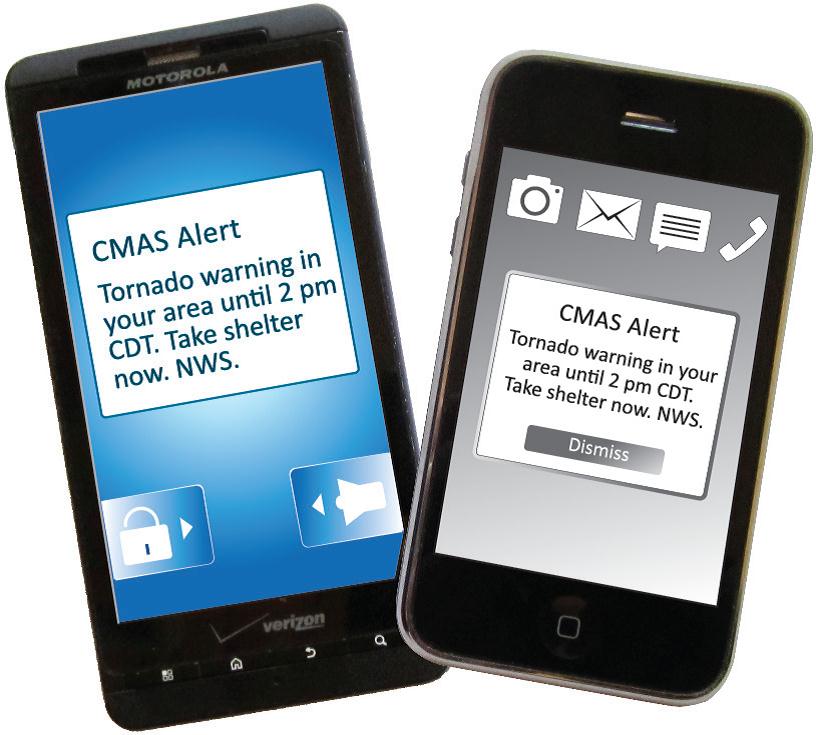
Will I be charged for receiving WEA messages?
No. This service is offered for free by wireless carriers. WEA messages will not count towards texting limits on your wireless plan.
Does WEA know where I am? Is it tracking me?
No. Just like emergency weather alerts you see on local TV, WEA are broadcast from area cell towers to mobile devices in the area. Every WEA-capable phone within range receives the message, just like every TV shows the emergency weather alert if it is turned on. TV stations, like WEA, don’t know exactly who is tuned in.
Will a WEA message interrupt my phone conversations?
No, the alert will be delayed until you finish your call.
How often will I receive WEA messages?
You may receive frequent WEA messages during an emergency. Message frequency depends on the number of imminent threats to life or property in your area.
If, during an emergency, I can’t make or receive calls or text messages due to network congestion, will I still be able to receive a WEA message?
Yes, WEA messages are not affected by network congestion.
What if I don’t want to receive WEA messages?
You can opt-out of receiving WEA messages for imminent threats and AMBER alerts, but not for Presidential messages. To opt out, please refer to instructions from your wireless carrier or visit http://www.ctia.org/wea for more information.
How will I receive alerts if I don’t have a WEA-capable device?
WEA is one of many ways you can receive emergency notifications. Other sources include NOAA Weather Radio, news media coverage, the Emergency Alert System on radio and TV broadcasts, social media, and other alerting methods offered by local and state public safety agencies. Your best use of WEA is to immediately seek additional information about the imminent threat impacting your area.
A flyer with more information about
Wireless Emergency Alerts is available.
Safe Room Q & A
What is a safe room? What are the design requirements for a FEMA safe room?
A safe room is a hardened structure specifically designed to meet FEMA criteria and provide "near-absolute protection" in extreme weather events, including tornadoes and hurricanes. The level of protection provided by a safe room is a function of its design parameters, specifically the design wind speed and resulting wind pressure and the wind-borne debris load resistance. To be considered a FEMA safe room, the structure must be designed and constructed to the guidelines specified in FEMA P-320, Taking Shelter
from the Storm: Building a Safe Room for Your Home or Small Business (FEMA, third edition, 2008a) (for home and small business safe rooms). Additionally, all applicable Federal, State, and local codes must be followed. When questions arise pertaining to the differences between FEMA P320 criteria and another code or standard, the most conservative criteria should apply.
Should I have a safe room?
Pages 6 through 10 of FEMA P-320 (FEMA, 2008a) provide background information to help homeowners decide if a safe room is needed in their home. Homeowners and small-business owners should also refer to the Homeowner’s Worksheet, Assessing Your Risk (Table I-1) in FEMA P-320 (FEMA, 2008a); this is an easy-to-use matrix that helps users decide whether a safe room is a matter of preference, should be considered, or is the preferred method for protection from extreme winds.
My house has a basement. Do I need a safe room?
Some strong tornadoes have resulted in loss of floor framing, collapse of basement walls, and death and injuries to individuals taking refuge in a basement. What constitutes an acceptable level of protection is an individual decision. A basement may be the safest place to seek shelter for homes without a safe room, but it will not provide the same level of protection as a safe room unless it has been designed and constructed to provide the level of protection in accordance with FEMA P-320 (FEMA, 2008a) and FEMA P-361 (FEMA, 2008b).
A basement is a good location to install a shelter or build a safe room, but access for handicapped or physically challenged individuals may be limited. The flood risk of your location may also affect whether it is appropriate to place a safe room in your basement. If your house or neighborhood is prone to flooding, the basement may not be an appropriate location for taking refuge.
Where can I find information about obtaining FEMA funding to construct a safe room? Are there any funds available in my area?
For project eligibility and financial assistance questions, please contact your Local Emergency Manager. Your Emergency Manager can advise you on what information must be provided for your project to be considered for funding, as well as any applicable Federal, State, and local design requirements.
Can I still apply for FEMA funding after I have begun construction of a safe room or purchased a safe room?
No. You must apply for funding before the purchase of a safe room or beginning any construction. Section D.2, Part III of FY 2011 Hazard Mitigation Assistance Unified Guidance (FEMA, 2010) states that costs related to projects for which actual physical work (such as groundbreaking, demolition, or construction of a raised foundation) has occurred prior to award or final approval are ineligible.
What costs are eligible for funding under a safe room grant?
Allowable costs for safe room projects funded under FEMA’s Hazard Mitigation Grant Program (HMGP) are those components related to, and necessary for, providing life safety for building residents in the immediate vicinity during an extreme-wind event. The funding covers design and building costs related to structural and building envelope protection. The funding covers both retrofits to existing facilities and new construction projects, and applies to both single- and multi-use facilities.
Eligible costs are only those consistent with FEMA-approved performance criteria as provided in FEMA P-320 (FEMA, 2008a). These criteria are summarized in Table 6 (below) of the 2011 FY FEMA Hazard Mitigation Assistance Unified Guidance (FEMA, 2010). (Click the table to view it larger.)

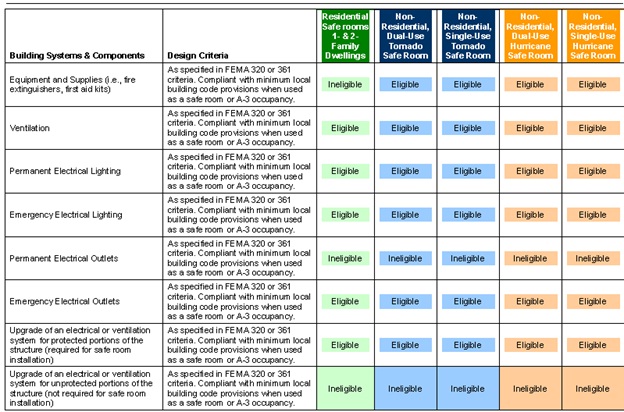
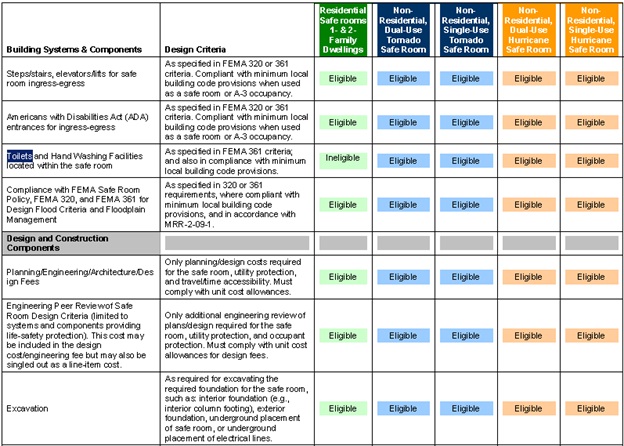

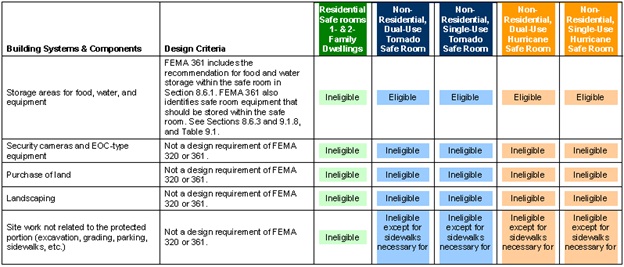
Does FEMA approve, endorse, or certify any products?
No. Federal No. Federal policy does not allow FEMA to approve, endorse, certify, or recommend any products. While a product may be in compliance with FEMA design guidance, any language from manufacturers stating their product is "FEMA approved" or "FEMA certified" is incorrect.
What is the recommended square footage per person for a residential tornado and hurricane safe room?
For residential safe rooms, the usable tornado safe room floor area should be the gross floor area minus the area of sanitary facilities, if any, and should include the protected occupant area between the safe room walls at the height of any fixed seating, if it exists. The minimum recommended safe room floor area per occupant for residential tornado and hurricane safe rooms is provided in table below. (Click the table to view it larger.)

What is the cost of installing a safe room in a new home or small business?
Costs for construction vary across the United States. The cost for constructing a safe room that can double as a master closet, bathroom, or utility room inside a new home or small business ranges from approximately $6,600 to $8,700 (in 2011 dollars). This cost range is applicable to the basic designs in FEMA P-320 (FEMA, 2008a) for an 8-foot by 8-foot safe room (approximately 64 square feet of protected space). Larger, more refined designs for greater comfort cost more, with 14 foot by 14-foot safe rooms ranging in cost from approximately $12,000 to $14,300. The cost of the safe room can vary significantly, depending on the following factors:
- The size of the safe room
- The location of the safe room within the home or small business
- The number of exterior home walls used in the construction of the safe room
- The type of door used
- The type of foundation on which the safe room is constructed
- The location of the home or small business within the United States
For additional cost information for small safe rooms in a home or small business, see FEMA P-320 (FEMA, 2008a), Section II, page 34.
As a homeowner, can I build the safe room on my own?
A homeowner who builds a safe room should be skilled in building construction. Some pre-fabricated safe rooms are available that require less building construction experience to successfully install. In purchasing any safe room, the homeowner should obtain sufficient documentation to determine that the safe room is built to the FEMA safe room design and protection criteria.
Can I install a safe room in an existing home?
Yes, though installing a safe room in an existing home or small business is typically more expensive and challenging than installing one in a new building. Modifying the walls or foundation of an existing building for the construction of a safe room is more complicated than constructing those elements new and, as a result, some of the prescriptive safe room designs provided in FEMA P-320 (FEMA, 2008a) are not practical for some existing homes. Typically, installing a safe room in an existing home costs 20 percent more than installing the same safe room in a new home under construction.
Due to the technical challenges involved in retrofitting an existing home for a safe room,
an architect or engineer should be consulted to address the structural issues and the wind-borne debris protection criteria, even when not required by the local building department. As such, homeowners must balance the desire to have protection within their home with the practicality of constructing a safe room outside the footprint of their existing home or structure for less money. For more information on retrofitting existing buildings with a safe room, see FEMA P-320 (FEMA, 2008a), Section II, page 25.
Is an underground safe room safer than one above ground?
As long as a safe room is designed to meet or exceed the criteria in FEMA P-320 (FEMA, 2008a) and FEMA P-361 (FEMA, 2008b), it will offer the same near-absolute protection whether it is above or below ground.
Where is the best location for the safe room?
There are several possible locations in or near your home or small business for a safe room. The most convenient location in many homes is in the basement. If there is no basement within the home, or if the walls of the basement do not meet FEMA P-320 (FEMA, 2008a) design criteria, an in-ground safe room can be installed beneath a concrete slab-on-grade foundation or concrete garage floor. In-ground and basement safe rooms provide the highest level of protection against missiles and falling debris because they are typically shielded from direct forces of wind and debris; however,
above-ground designs, such as the prescriptive designs provided in FEMA P-320 (FEMA, 2008a) or any solution following the criteria set forth in FEMA P-361 (FEMA, 2008b) will provide near-absolute protection.
Many individuals prefer to build within their homes or buildings so they have some level of
protection while attempting to access their safe room. For an existing home or small business, this convenience must be balanced with the challenges of retrofitting the building. For more information on selecting the location of a safe room within your home or small business, see FEMA P-320 (2008a), Section II, page 27.
Are inspections required?
Obtaining proper building permits and inspections is important for all construction. The builder or homeowner should ensure the safe room is built according to the plans in FEMA P-320 (FEMA, 2008a) or to plans that, through testing and engineering, have been determined to meet the safe room design criteria in FEMA P-320 (FEMA, 2008a) or FEMA P-361 (FEMA, 2008b). The level of construction needed for a safe room typically requires a permit from the local building department. Further, to verify compliance with the FEMA or International Code Council (ICC)-500 (ICC, 2008) criteria, additional quality control inspections for community safe rooms, and often for residential safe rooms, may be needed.
If the Storm shelter costs $6,000.00 can I get more than $2,000 reimbursed?
No, the Hazard Mitigation Program only allows reimbursements up to 75% of the approved costs.
I need to have my Storm Shelter money up front to pay my contractor. Is this possible?
No, The money is only available as a reimbursement, AFTER construction is completed and you have submitted signed and notarized documentation from your contractor stating your Storm Shelter meets or exceeds the specification set forth in FEMA Publication 320.
If I am eligible to receive the $2,000 rebate, do I have to consider that money as income for State and Federal Income Tax purposes?
No, in accordance with the Robert T. Stafford Disaster Relief and Emergency Assistance Act, as amended, these funds are considered free from tax liability under Federally funded assistance programs.
Mutual Aid Members
| |
| Amherst Volunteer Fire Department |
| Elm Creek Volunteer Fire Department |
| Gibbon Volunteer Fire Department |
| Kearney Volunteer Fire Department |
| Miller Volunteer Fire Department |
| Pleasanton Volunteer Fire Department |
| Ravenna Volunteer Fire Department |
| Shelton Volunteer Fire Department |
| Buffalo County Emergency Management |
| Buffalo County Sheriff's Office |
| Kearney Police Department |
| Good Samaritan Hospital |
Family Disaster Plan
Disaster can strike quickly and without warning. It can force youto evacuate your neighborhood or confine you to your home. What would you do if basic services--water, gas, electricity or telephones--were cut off? Local officials and relief workers will be on the scene after a disaster, but they will not be able to reach everyone right away, so it is important for you to develop a plan for you and your family.
Families can, and do, cope with disaster by preparing in advance and working together as a team. Follow the steps below to create your family's disaster plan. Knowing what to do is your best protection and your responsibility.
Where will your family be when disaster strikes? They could be anywhere--at work, at school or in the car.
How will you find each other? Will you know if your children are safe?
4 STEPS TO SAFETY
1. Find Out What Could Happen to You
Contact the Emergency Management office or the Ft. Kearney Chapter of the American Red Cross.
- Ask what types of disasters are most likely to happen in Kearney and the surrounding area. Request information on how to prepare for the different types of emergencies that could occur.
- Learn about the existing warning signals in Buffalo County: what they sound like (outdoor warning sirens), and that the alert signal should indicate to all citizens to tune to local radio or television for emergency information and instructions.
- Ask about animal care after a disaster. Animals will not be allowed inside emergency shelters due to health regulations, so prepare a plan for your pets.
- Find out how to help elderly or disabled persons, if needed.
- Next, find out about the disaster plans at your workplace, your children's school or daycare center and other places where your family spends time.
2. Create a Disaster Plan
Meet wiith your family and discuss why you need to prepare for disaster. Explain the dangers of fire, severe weather and hazardous materials to children. Plan to share responsibilities and work together as a team.
- Discuss the types of disasters that are most likely to happen. Explain what to do in each case.
- Pick two places to meet;
- Right outside your home in case of a sudden emergency, like a fire.
- Outside your neighborhood in case you can't return home. Everyone must know the address and phone number.
- Ask an out-of-state friend to be your "family contact." After a disaster, its often easier to call long distance. Other family members should call this person and tell them
where they are. Everyone must know your contact's phone number.
- Discuss what to do in an evacuation. Plan how to take care of your pets.
3. Complete This Checklist
- Post emergency telephone numbers by your telephones or have them programmed into your phone (fire, police, EMS, etc.)
- Teach children how and when to call 911 for emergency help.
- Show each family member how and when to turn off the water, gas and electricity at the main switches.
- Check if you have adequate insurance coverage.

- Teach each family member how to use a fire extinguisher (ABC type), and show them the designated locations where they are kept in the house.
- Install smoke detectors on each level of your home, especially near bedrooms.
- Conduct a home hazard hunt.
- Stock emergency supplies and assemble a Disaster Supplies Kit.
- Take a Red Cross first aid and CPR class.
- Determine the best escape routes from your home. Find two ways out of each room.
- Find the safe spots in your home for each type of disaster, including your Shelter-in-Place spot.
4. Practice and Maintain Your Plan
- Quiz your children every six months so they remember what to do.
- Conduct fire and emergency evacuation drills.
- Replace stored water every three months and stored food every six months.
- Test and recharge your fire extinguisher(s) according to manufacturer's instructions.
- Test your smoke detectors monthly and replace the batteries the same weekend as the time change occurs in the spring (daylight-savings time) and fall (standard time).
EMERGENCY SUPPLIES
Keep enough supplies in your home to meet your needs for at least three days. Assemble a Disaster Supplies Kit with items you may need in an evacuation. Store these supplies in sturdy, easy-to-carry containers such as backpacks, duffle bags or covered plastic containers. Include:
- A three-day supply of water (one gallon per person per day) and food that won't spoil.

- One change of clothing and footwear per person, and one blanket or sleeping bag per person.
- A first aid kit that includes your family's prescription medications.
- Emergency tools, including a battery-powered radio, flashlight and plenty of extra batteries.
- An extra set of car keys and a credit card, cash or traveler's checks.
- Sanitation supplies.
- Special items for infant, elderly or disabled family members.
- An extra pair of glasses.
- Keep important family documents in a waterproof container. Keep a smaller kit in the trunk of your car.
UTILITIES
Locate the main electric fuse box, water service main and natural gas main. Learn how and when to turn these utilities off. Teach all responsible family members. Keep necessary tools near gas and water shut-off valves.
Remember, turn off the utilities only if you suspect the lines are damaged or if you are instructed to do so. If you turn the gas off, you will need a professional to turn it back on.
NEIGHBORS HELPING NEIGHBORS
Working with neighbors can save lives and property. Meet with your neighbors to plan how the neighborhood could work together after a disaster until help arrives. If you're a
member of a neighborhood organization, such as a home association or neighborhood watch group, introduce disaster preparedness as a new activity. Know your neighbors' special skills (e.g., medical, technical) and consider how you could help neighbors who have special needs, such as disabled and elderly persons. Make plans for child-care in case parents are unable to get home during the emergency.
HOME HAZARD HUNT
During a disaster, ordinary objects in your home can cause injury or damage. Anything that can move, fall, break or cause a fire is a home hazard. Inspect your home at least once a year and fix potential hazards.
Contact the Kearney Volunteer Fire Department to learn about home fire hazards.
EVACUATION
Evacuate immediately if told to do so:
- Listen to your battery-powered radio and follow the instructions of local emergency officials.
- Wear protective clothing and sturdy shoes.
- Take your family disaster supplies kit.
- Lock your home.
- Use travel routes specified by local authorities--don't use shortcuts because certain areas may be impassable or dangerous.
If you're sure you have time:
- If instructed to do so, shut off water, gas and electricity before leaving.
- Post a note telling others when you left and where you are going.
- Make arrangements for your pets.
IF DISASTER STRIKES
- If disaster strikes
Remain calm and patient. Put your plan into action.
- Check for injuries
Give first aid and get help for seriously injured people.
- Listen to your battery powered radio for news and instructions.
- Evacuate, if advised to do so. Wear protective clothing and sturdy shoes.
Check for damage in your home...
- Use flashlights--do not light matches or turn on electrical switches, if you suspect damage.

- Check for fires, fire hazards and other household hazards.
- Sniff for gas leaks, starting at the water heater. If you smell gas or suspect a leak, turn off the main gas valve, open windows, and get everyone outside quickly.
- Shut off any other damaged utilities.
- Clean up spilled medicines, bleaches, gasoline and other flammable liquids immediately.
Remember to...
- Confine or secure your pets.
- Call your family contact--do not use the telephone again unless it is a life-threatening emergency.
- Check on your neighbors, especially elderly or disabled persons.
- Make sure you have an adequate water supply in case service is cut off.
- Stay away from downed power lines.
The Federal Emergency Management Agency's Family Protection Program and the American Red Cross' Disaster Education Program are nationwide efforts to help citizens prepare for disasters of all types. For more information, please contact the Emergency Management office, or the Fort Kearney Chapter of the American Red Cross. Start planning now.
Links & Resources for Veterans
[Note: All external links will open in a new browser window]
Policy for Subdivision Road Maintenance
Buffalo County will (may) provide public road top only maintenance
within established subdivisions on the following basis:
Subdivision must be properly platted and recorded with established
roads dedicated to the public.
Subdivision must present the County Board of Commissioners
a petition for such maintenance signed by a majority of property
owners.
Maintenance will be on a "Low-priority" basis,
as compared to "Regular or High-priority" main roads,
school bus routes, emergency roads, section line and half section
line roadways.
The County may require the subdivision to improve roads to
minimum standards if there is difficulty operating maintenance
vehicles because of such conditions. The cost of their improvement
or any other significant road improvements shall be the financial
responsibility of the subdivision.
Each subdivision should have an alternate snow removal plan
in the event that emergency situations dictate the use of
equipment elsewhere.
It is further recommended that each subdivision's governing
body or committee appoint one representative within the subdivision
to communicate problems or questions to the County Road Department.
Subdivision Road Specifications, RL-3
Minimum Right of Way-66 feet requirement
Design Speed (MPH)-30 MPH or less
Maximum Curve (degree)-23.0 degree
Maximum Grade (%)-10%
Number of Lanes-2
Lane Width-10 feet each
Shoulder Width (feet)-3 feet
Lateral Obstacle Clearance (feet)-5 feet
Surface Type Minimum--Gravel
Drainage Facilities
Buffalo County will require the number of structures to
accommodate adequate water drainage (culverts and bridges), as well
as adequate drainage ditches to insure a safe travel surface for the
traveling public. The County will not be responsible for any drainage
structures that have not met requirements.
Turn Arounds
Minimum radius of 66.0 feet on dead end roads for adequate machine
turn arounds.
Signing
Proper signing will be required on intersections within the
subdivision as well as on main roads outside and/or leading into a
subdivision. This includes proper dead end signs, obstacle markers and
speed signs.
Driveways
Paved and hard surfaced driveways will be the responsibility of the landowner
in the event of any reconstruction or maintenance work. New driveways within
the subdivision are the responsibility of the landowner. Landowners must obtain
a driveway permit from the County Highway Department, whereupon the Highway
Department will check the location for drainage and/or culvert size. If a
culvert is required, it will be the responsibility of the landowner to purchase
the culvert and install it.
Trees, Etc.
Trees, shrubbery or flowers will not be allowed within the 66.0 feet of
right of way, nor will fences be allowed within this right of way.
Snow Removal
Snow removal will consist of the traveled surface only as low priority.
Driveways will be the responsibility of the landowner or tenant.
Maintenance
Those gravel roads within the subdivision will be treated as low priority
as compared to other County gravel roads. Paved or hard surface roadways within
the subdivision will be the responsibility of the subdivision as far as maintenance,
patching, resurfacing or complete reconstruction. Buffalo County will assume snow
removal of the traveled roadway only. Any outside construction or maintenance work
done on those roads within the subdivision by a contractor or resident will not be
the responsibility of Buffalo County liability and/or cost.
For additional information, please contact the Highway Department at 308-236-1237.
County Benefits
The Buffalo County Veterans Service Office offers the following benefits for those veterans who are eligible:
County Veterans Aid Fund
The CVA fund is a temporary emergency fund to assist veterans, their spouses, and dependents when there is an unforeseen emergency and there are no other resources available. Eligible veterans are persons who served on active duty, received an Honorable Discharge, and served during one of the defined "wartime eras" and who have resided in Nebraska for at least one year, and Buffalo County for at least six months. Applicants may request assistance with food, shelter, clothing, funeral, medical, dental, and surgical items. The applicant must apply through the County Service Office in Buffalo County. This is an "aid" program so the veteran must demonstrate an "inability" to meet the obligation to pay these bills, via an application.
Bronze Grave Flag Holders
State of Nebraska statute requires the County Veterans Service Office to provide a flag holder reflecting the veterans wartime era. The Buffalo County, Veterans Service Office also annually inventories these flag holders to insure they remains on the correct grave and we replace damaged markers.
Registration of DD214s
Buffalo County records a "certified copy" of the original copy of a veterans military separation document (DD-214). Once recorded the veteran may call us from any where in the world and we will provide them with a "certified copy" when needed.
Homestead Exemption
Annually, the Buffalo County Veterans Service Office obtains a letter from the VA Regional Office that establishes who are eligible veterans (or widows) for a tax exemption on their personal residence. These letters are provided to the County Assessor.
Grave Registration
Upon notification of the burial of a veteran in Buffalo County we complete a "grave registration card". We maintain a copy here in Buffalo County, and the original is sent to the State of Nebraska, Department of Veteran's Affairs in Lincoln. We also order a "Presidential Memorial Certificate" for the family of all deceased Buffalo County veterans.
Surveyor
County surveyor powers and duties:
(1) It shall be the duty of the county surveyor to make or cause to be made all surveys within his or her county that the county surveyor may be called upon to make and record the same.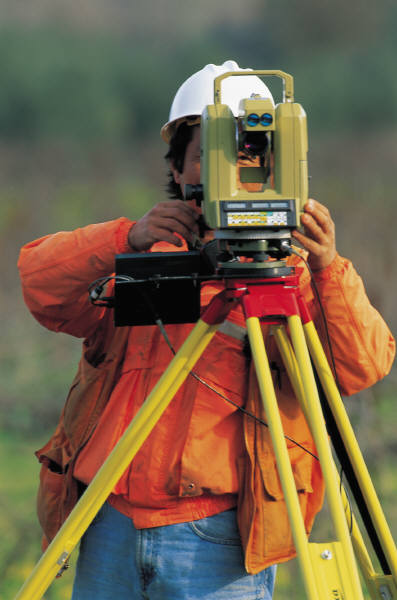
(2) The county surveyor shall prepare and file the required annual inventory statement of county personal property in his or her custody possession as provided in sections 23-346 to 23-350.
Trespass; exemption from liability. The county surveyor in the performance of his official duties, shall not be liable to prosecution for trespass.
Original corners; perpetuation. It shall be the duty of the county surveyor in surveys made by him or her to perpetuate all original corners not at the time well marked, and all corners or angles that he or she may establish or reestablish, in a permanent manner by setting monuments containing ferromagnetic material, according to the instructions of the State Surveyor.
Corners; establishment and restoration; rules governing. The boundaries of the public lands established by the duly appointed government surveyors, when approved by the Surveyor General and accepted by the government, are unchangeable, and the corners established thereon by them shall be held and considered as the true corners which they were intended to represent, and the restoration of lines and corners of said surveys and the division of sections into their legal subdivisions shall be in accordance with the laws of the United States, the circular of instructions of the United States Department of the Interior, Bureau of Land Management, on the restoration of lost and obliterated section corners and quarter corners, and the circular of instructions to the county surveyors by the State Surveyor under authority of the Board of Educational Lands and Funds. The county surveyor is hereby authorized to restore lost and obliterated corners of original surveys and to establish the sub divisional corners of sections in accordance with the provisions of the section and section 23-1907. Any registered land surveyor registered under the provisions of sections 81-8,108 to 81-8,127 is hereby authorized to establish any corner not monumented in the original government surveys in accordance with the provisions of this section 23-1907. Subdivision shall be executed according to the plan indicated by the original field notes and plats of surveys and governed by the original and legally restored corners. The survey of the sub divisional lines of sections in violation of this section shall be absolutely void.
Surveys; records; contents; available to public. The county surveyor shall record all surveys, for permanent purposes, made by him or her, as required by sections 81-8,121 to 81-8,122.02. Such record shall set forth the names of the persons making the application for the survey, for whom the work was done, and a statement showing it to be an official county survey or resurvey. The official records, other plats, and field notes of the county surveyor's office shall be deemed and considered public records. Any agent or authority of the United States, the State Surveyor or any deputy state surveyor of Nebraska, or any surveyor registered pursuant to sections 81-8,108 to 81-8,127, shall at all times, within reasonable office or business hours, have free access to the surveys, field notes, maps, charts, records, and other papers as provided for in sections 23-1901 to 23-1913. In all counties, where no regular office is maintained in the county courthouse for the county surveyor of that county, the county clerk shall be custodian of the official record of surveys and all other permanent records pertaining to the office of county surveyor.
Land surveying. Land surveying shall mean the establishment or reestablishment of corners and the boundaries and the location of lots, parcels, tracts, or divisions of land, which may include distance, direction, elevation, and acreage, and the correct determination and description of lots, parcels, tracts, or divisions of land for, but not limited to, any of the following purposes:
- To furnish a legal description of any tract of land to be used in the preparation of deeds of conveyance when the description is not the same as the one in the deed of conveyance to the current owner or when bearings, distances, or measurements are needed to properly describe the tract being conveyed
- To furnish a legal description of any land surveyed to be used in the platting or subdividing of the land
- To determine the amount of acreage contained in any land surveyed
- To furnish a topographic plat of a lot, parcel, tract, or division of land and locating natural and artificial features in the air, on the surface or subsurface of the earth, and on the beds or surface of bodies of water for the purpose of establishing the facts of size, area, shape, topography, and orientation of improved or unimproved real property and appurtenances to the real property.
Office Hours: Monday - Friday 8:00am-5:00pm
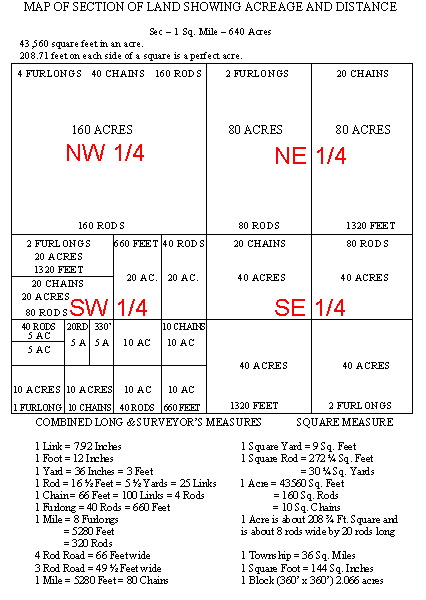
Highway
 View on map View on map
There are approximately 962
square miles in Buffalo
County. Within this area there are 1500 miles of
road: 112.3 miles are County oil or concrete roads. There are 342 bridges over 20 feet in the
County. There are also 242 bridges that
are 20 feet and under which are not considered bridges but are classified as
culverts because of the constricted water flow.

There are 41 full time employees
and during the summer months we employ three to four more people. In addition to the Highway Superintendent,
there are: one assistant Highway Superintendent, two clerical, two foremen, 19
maintainer operators, five heavy equipment operators, one sign man, one welder,
two mechanics, one mechanic assistant and eight truck driver/operators.
We also have a large inventory of
machines and equipment valued at $9,143,598.00. This includes 21 maintainers, one crane, three backhoes, four loaders, 43
pickups and trucks and a considerable number of other pieces of equipment.
We have an excellent
communication system which includes 2-way radios which are used extensively. They save many miles of driving and enable
people to communicate from one corner of the county to the other. They have saved many maintainer men from
having to walk for help after having a flat tire, being stuck in a snowstorm or
any other emergency type situation. Our
foremen also have cellular phones.
We have 2-way radios in all the
maintainers, office, loaders and in a majority of our other equipment. The radios also give us communication with
the Sheriff’s Department an the County
Surveyor. The telephone system gives us easier
communication with the Sheriff’s Department, Surveyor, other County Courthouse
offices and also the City of Kearney
offices by dialing just four digits.

Buffalo County is divided into 26
Townships. We have divided the townships
into Zones 1 through 26. We bid gravel
once a year. The bid period is from
April 1 of one year to March 31 of the following year.
Buffalo County went to the GEO Base Addressing System and signs were installed in 1997. This system makes finding a resident faster in an emergency type situation.
Schedule of Recording Fees
Filing Fees (New as of January 1, 2013)
LB-14 (Neb.Rev.Stat.33-109)
- 1st page of document: $10.00
- 2nd page & all subsequent pages: $6.00 each
- The above fees pertain to ALL documents filed within the Register of Deeds offices.
Exceptions listed below are "no fee" documents:
- Federal Tax Lien Termination
- State Tax Lien Termination
- UCC Termination
- Relinquishment
- Certified copies: $1.50 per page
- UCC Financings Statements, Assignment, Amendments, Release, Partial Release: Flat Fee $14.00 (Change effective date 7/1/2021) LB 910 passed 7/31/2020
Documentary Tax—Effective September 3, 2025 - Pursuant to NE LB 78 for Nebraska will change to $2.32 per $1,000.
(see the Computation Table) The Nebraska Department of Revenue requires the Register of Deeds office to collect a documentary-stamp tax when a deed is presented for recording
A Form 521 (transfer statement) must be completed for all deeds, memorandum of contracts and/or land contracts.
Copies are $0.50 per page plus $1.00 P&H to mail out
Faxes are $0.50 per page
Money is needed before copies are sent.
Buffalo County Plat & Tam Books-showing ownership - $12.00
The above list of fees are in accordance with LB463 L.S. 1983: Effective August 26, 1983; LB606 L.S. 1985 Effective July 1, 1985; LB1153, Effective January 1, 1991 LB 1022, Effective January 1, 1993; LB1099, Effective July 16, 2004
LB 254 - Provide New Requirements for Instruments recorded in the Office of Register of Deeds Effective August 27, 2011
- Recording Space Requirements:
- 3" X 8 1/2" on top of page 1
- No attachment or affirmation shall be used in any way to cover any information or printed material on the instrument. (For example, nothing may be taped or attached to an instrument.)
- Every instrument presented for recording shall have on the first page BELOW the 3 inch margin a return address and the title of the document
- Margin Requirements: 1" on both vertical sides, and 1" on the bottom. This applies throughout the document.
- Instrument Requirements:
- Paper at least 8 1/2" X 11" , and no larger than 8 1/2" X 14"
- Shall be printed, typewritten or computer generated in black ink, white paper, and a minimum 8pt font
- Must be legible
- Each signature on an instrument shall be in black or dark blue ink
- Names of each party shall be typed, printed, or stamped beneath the original signature.
- Stamps shall not cover or interfere with any part of the instrument
- Exceptions to the rule:
- Instruments signed before the effective date of this bill (August 27, 2011)
- Instruments executed outside of the U.S.
- Certified copies from governmental agencies (Death Certificates)
- Instruments signed by an incapacitated or deceased person at the time of recording
- Instruments formatted to meet court requirements
- State & Federal Tax Liens
- UCC Instruments
- Plats, Surveys, etc.
Sheriff
 View on map View on map
How to enter the Detention Center
"Serving Buffalo County with the assistance of our citizens!" 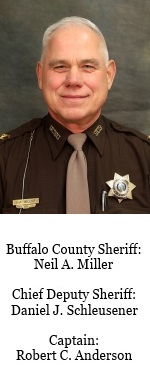
Mission Statement: "The mission of the Buffalo County Sheriff's Department is to enhance the quality of life in our county by working cooperatively with the public and within the framework of the U.S. Constitution to enforce the law, preserve the peace, reduce fear and provide for a safe environment for all of our citizens."
Department Structure: The Buffalo County Sheriff's Office is organized into two divisions, Operations and Support Services, under the direction of the Sheriff who is elected for a four (4) year term. The Operations Division consists of Civil Process, Warrant Section, Investigative Section, and Patrol Section and is currently managed by a Captain. The Support Services Section consists of the Sheriff's
Staff Section, Community Services Section, Training Section, Communications Section, and Detention Center Section and is currently managed by the Chief Deputy.
Social Media:
 
LOCATION: The department offices are located at 2025 Avenue A in Kearney, Buffalo County, Nebraska.
Regular business hours are 8:00 a.m. to 5:00 p.m. Monday - Friday.
A unique joint venture with the Buffalo County Sheriff's Office and the Kearney Police Department was formed in July 1993 when both agencies co-located to a remodeled building in downtown Kearney. By sharing resources, both agencies save taxpayers' money as well as establishing a good working relationship between the agencies and their employees.
The Sheriff's office oversees the dispatch duties and answers 911 calls for officers of both agencies.
The Police Department oversees the records and data processing functions for both agencies.
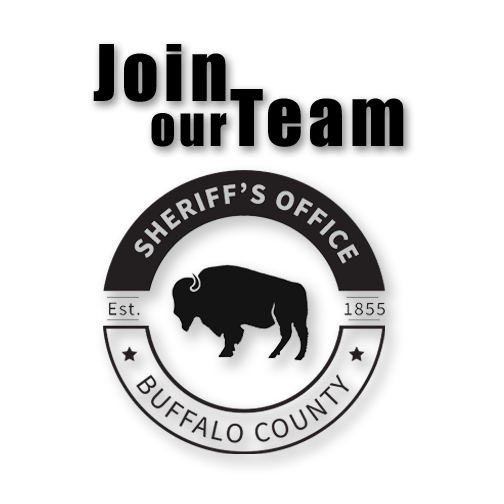
The Buffalo County Sheriff's Office responds to calls that occur in the county (outside of Kearney city limits). The Kearney Police Department responds to calls that occur within the city limits.
Both agencies assist each other as needed as well as working with law enforcement officers from other local jurisdictions in Buffalo County, Public Safety at the University of Nebraska at Kearney, and the Nebraska State Patrol.
Civilian fingerprinting is available by Buffalo County Sheriff's Office. BY APPOINTMENT ONLY.
1) Call 308-236-1804 to schedule an appointment, Monday - Friday, 8:30-11:00 am and 1:00 - 4:00 pm.
2) Fee is $20.
3) Do not come if experiencing any symptoms that include.
a) fever of above 100 F
b) shortness of breath or difficulty breathing.
For Emergencies: Dial 911
2022 PREA Audit
2023 PREA Annual Report
Disclaimer Statement
NOTICE
The information provided by this service resides on a computer system funded by the County of Buffalo, Nebraska. Anyone using this service consents to the monitoring of their use of this service by the computer system providers, authorized County of Buffalo, Nebraska employees, as well as security or law enforcement personnel. Communications made through this service's electronic mail and Messaging system shall, in no way be deemed to constitute a filing with or legal notice to the County of Buffalo or any of its agencies, departments, authorities, officers, directors, employees, agents or representatives, with respect to any existing or potential claim or cause of action against the County or any of its agencies, departments, authorities, officers, directors, employees, agents or representatives, where notice to the County is required by any federal, state or local law, rule or regulation.
Government Offices can only accept written documents for filing into official government records unless specific statutory language authorizes filings done by other than written medium.
PRIVACY POLICY
The protection of individual privacy is a concern to Buffalo County. Buffalo County has created this privacy statement in order to demonstrate its firm commitment to privacy. The following discloses our information gathering and dissemination practices for this site.
Information You Provide to Us:
Buffalo County does not keep any personal information about you or your visit to our Internet site unless you have specifically supplied it to us. If you may have supplied us with information as part of a request for information or to e-file an appeal of your Board of Property Assessment decision. This also applies to any feedback or on-line survey information you may have sent us through our website. In cases where you have supplied us with information, including financial data, we will treat such information in accordance with the requirements of the law. This means that it will be treated in the same way as written forms of communication, and in many instances it will be considered public information available to the public upon request. To the extent allowed by law, Buffalo County will make reasonable attempts to protect personal financial information from disclosure.
Public Disclosure:
As a general rule, Buffalo County does not disclose any personally identifiable information collected online except where you have given us permission or where the information is public information under the Nebraska Public Records Act et seq., or other applicable laws. Visitors should be aware that information collected by the County on its websites may be subject to examination and inspection if such information is a public record and not otherwise protected from disclosure.
Other Information about Your Visit to Our Site:
Our web site does not automatically collect any information from your computer during your visit. Certain pages, however, may tally total number of visitors.
This privacy policy does not apply to web sites operated by third parties that you may access through a link from our web site.
DISCLAIMER OF WARRANTIES
The County of Buffalo makes no warranty or representation, express or implied, including but not limited to warranties of merchantability and fitness for a particular purpose. The County of Buffalo assumes no liability or responsibility for the quality, content, accuracy, completeness of the information, text, graphics, links and any other items contained on this service or any other system or service. The materials contained on this service have been compiled from a variety of sources and are subject to change without notice. Commercial use or sale of the materials contained on this service is prohibited without the express written consent of the County of Buffalo. In no event will the County of Buffalo be liable for any damages whatsoever, whether direct, indirect, consequential, incidental or special, or any claim for attorney's fees arising out of the use or inability to use the information on this service, even if the County of Buffalo is advised of the possibility of such damages.
COPYRIGHT STATUS
All documents available on this service may be protected under the United States and/or Foreign Copyright Laws. Permission to reproduce may be required. The County of Buffalo retains all rights to the information provided by this service, including, but not limited to, the right of reproduction.
DISCLAIMER OF ENDORSEMENT
Reference herein to any specific commercial products, process, or service by trade name, trademark, manufacturer, or otherwise, does not necessarily constitute or imply its endorsement, recommendation, or favored status by the County of Buffalo. The views and opinions of authors expressed on this service do not necessarily state or reflect those of the County of Buffalo, and shall not be used for advertising or product endorsement purposes.
The County of Buffalo is not, and shall not bear any responsibility for the contents of any off-site pages referenced.
Welcome
We invite you to browse our web site to learn about our various County offices and the services Buffalo County, Nebraska offers its citizens.
LB304 - Annual Memberships
Follow us on for current info as well. for current info as well.
This web site contains information about County programs,services, departments and offices, as well as helpful information oncommonly asked questions. We encourage you to use this site frequently to access meeting notices, Open Meetings Act, agendas, packets, and minutes of the County Board of Commissioners.
Buffalo County uses Beacon Bid to share solicitations with suppliers. Click on any solicitation and fill out the free form on Beacon. Or subscribe for free updates for our future bids and RFPs. You will receive an email with the link to download attachments. Please note that accurate contact information is required in order to receive any updates.
Beacon is free for bidders.
|